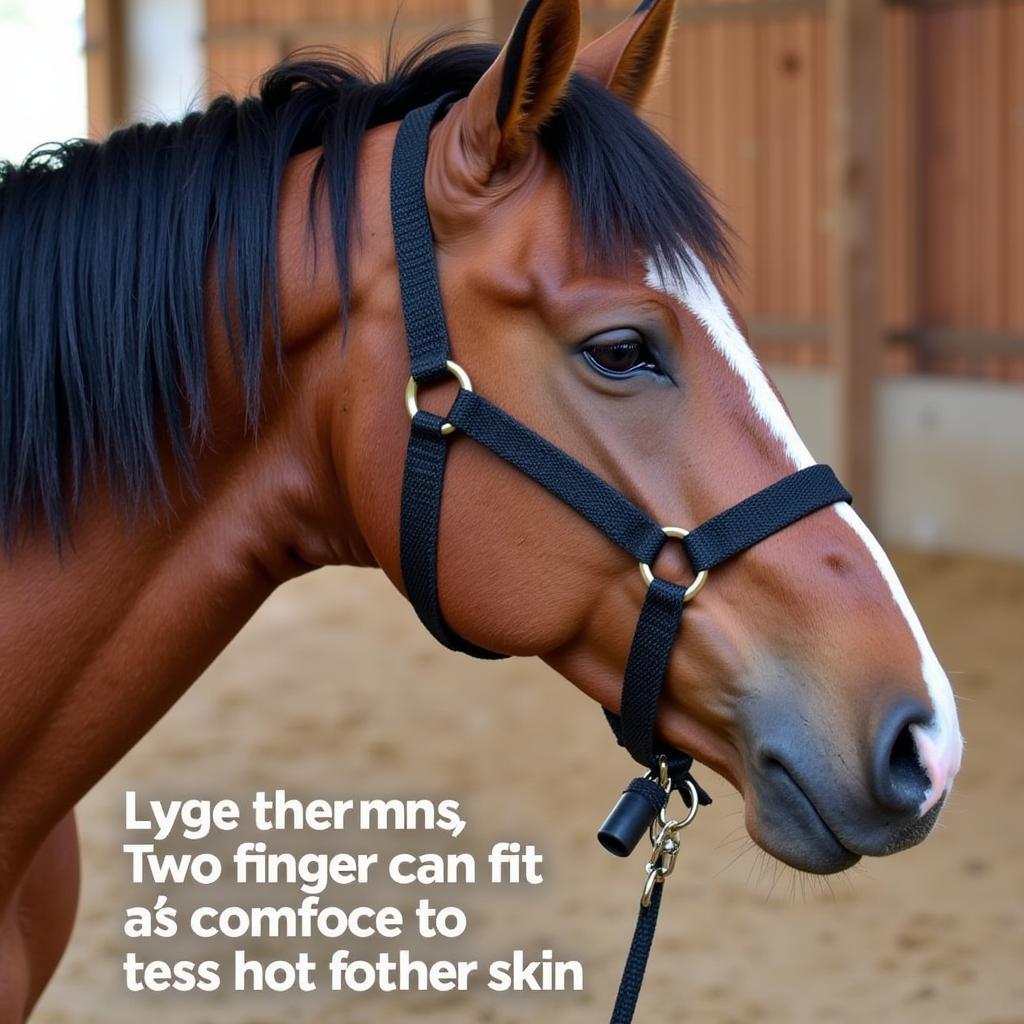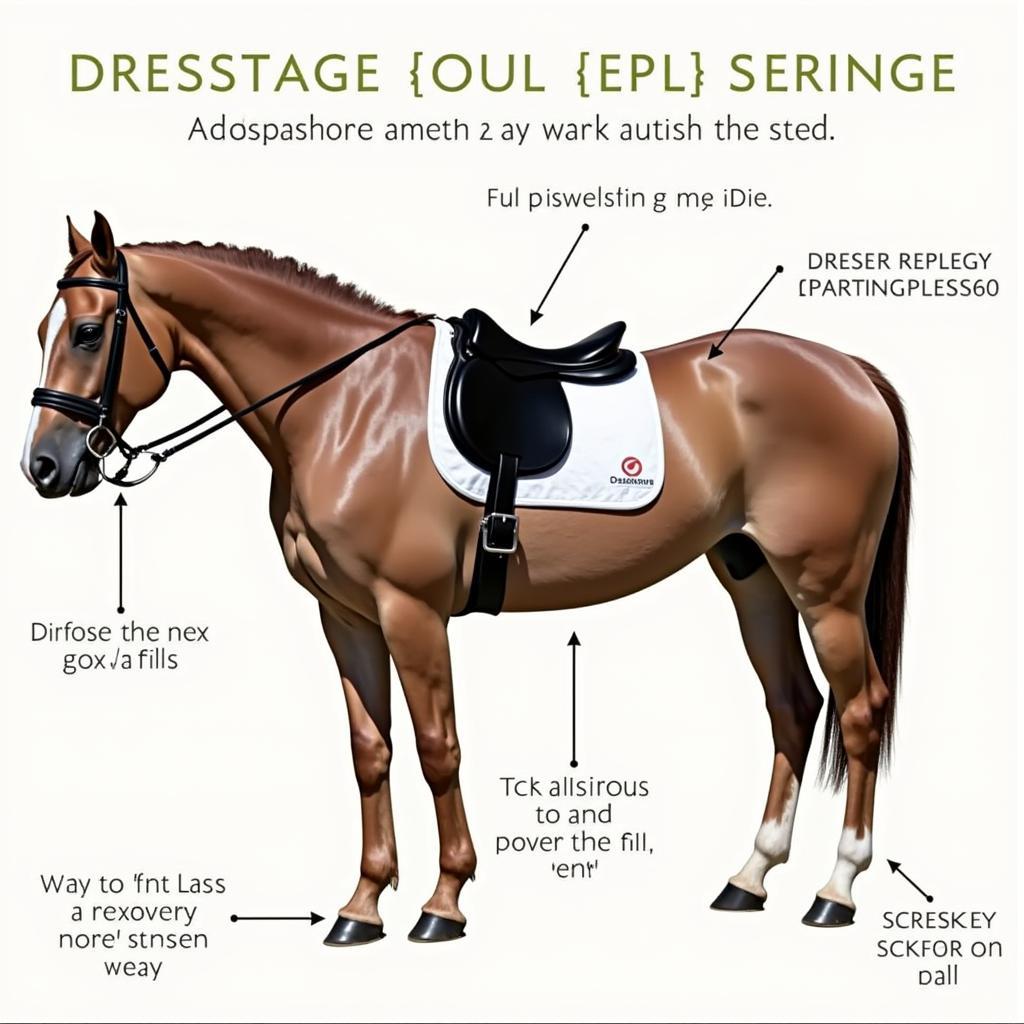Horses With Tack are a common sight, whether you’re at a stable, a horse show, or simply out on a trail ride. Tack refers to the equipment used on horses, and understanding its purpose and proper usage is essential for both the horse’s well-being and the rider’s safety. This guide will delve into the world of horses with tack, covering everything from basic halters to specialized saddles.
Riding a horse with proper tack enhances communication and control, enabling a deeper connection between horse and rider. Choosing the right tack involves considering the horse’s size, breed, discipline, and the rider’s experience level. For example, a horse used for barrel racing will require different tack than a horse used for dressage. This is why understanding the various types of tack and their functions is so crucial.
Essential Horse Tack: An Overview
From the simplest nylon halters for horses to the more complex bridles and saddles, each piece of tack plays a vital role. Halters are used for leading and tying horses, while bridles provide control through the bit and reins. Saddles offer a secure and comfortable seat for the rider and distribute the rider’s weight evenly across the horse’s back. Choosing the correct type and size of each piece is paramount for the horse’s comfort and safety.
Halters and Lead Ropes: The Basics
Halters, often made of nylon or leather, fit around the horse’s head and allow for leading and tying. A lead rope is attached to the halter and allows the handler to guide the horse. Properly fitted halters should be snug but not tight, allowing for two fingers to fit comfortably between the halter and the horse’s skin. Lead ropes should be strong and durable, yet comfortable to hold. Knowing how to properly tie a horse using a quick-release knot is essential for safety.
 Horse wearing a properly fitted halter and lead rope
Horse wearing a properly fitted halter and lead rope
Bridles: Communication and Control
Bridles, more complex than halters, are used for riding and driving. They include a headstall, bit, and reins. The bit sits in the horse’s mouth and provides communication between the rider and horse. Different disciplines require different types of bits, each designed for specific purposes and riding styles. Reins are attached to the bit and allow the rider to control the horse’s direction and speed.
Saddles: Comfort and Security
Saddles are designed to provide a comfortable and secure seat for the rider while distributing weight evenly across the horse’s back. There are various types of saddles, each designed for a specific equestrian discipline. English saddles are commonly used for disciplines such as jumping and dressage, while Western saddles are typically used for trail riding and working cattle. Proper saddle fit is essential for both the horse’s comfort and the rider’s effectiveness.
Choosing the Right Tack: Factors to Consider
Selecting the appropriate tack for your horse involves several considerations. These include the horse’s size and breed, the intended discipline, and the rider’s skill level. A professional saddle fitter can help ensure a proper fit, preventing back problems and discomfort for the horse.
“A properly fitted saddle is crucial for the horse’s well-being,” says renowned equine veterinarian Dr. Emily Carter. “An ill-fitting saddle can cause pain, pressure points, and even long-term back problems.”
 Different types of saddles for various disciplines
Different types of saddles for various disciplines
Tack Care and Maintenance
Regular cleaning and maintenance of your horse’s tack are essential for its longevity and the horse’s comfort. Leather tack requires regular conditioning to prevent drying and cracking. Metal parts should be cleaned and inspected for wear and tear. Proper care ensures that the tack remains functional and safe to use.
Beyond the Basics: Specialized Tack
Beyond the essential tack items, there is a wide range of specialized equipment designed for specific disciplines and purposes. This includes items like martingales, breastplates, and different types of bits. Understanding the purpose and proper use of these specialized pieces is vital for effective riding and horse welfare. You might also want to check out a hay ball feeder for horses.
 Horse with full tack for dressage competition
Horse with full tack for dressage competition
“Investing in quality tack and maintaining it properly are essential for any horse owner,” advises experienced horse trainer, John Miller. “It’s an investment in your horse’s comfort and your own safety.”
Conclusion
Horses with tack are a partnership, and understanding the purpose and function of each piece of equipment is crucial for a harmonious relationship between horse and rider. By choosing the right tack, maintaining it properly, and using it correctly, we can ensure the comfort, safety, and well-being of our equine partners. Choosing the right tack can make all the difference, much like choosing the right breyer horses and tack. Or if you are looking for a specific type of horse in a certain area, you may want to browse horses for sale austin.
FAQ
- What is the most basic horse tack? A halter and lead rope.
- Why is saddle fit so important? To prevent back problems and discomfort for the horse.
- What are the main types of saddles? English and Western.
- How often should tack be cleaned? Regularly, depending on usage.
- What is the purpose of a bridle? To provide communication and control while riding.
- Why is a headsetter for horses beneficial? It can help with training and control.
- What material is most common for halters? Nylon or leather.
When you need support, please contact Phone Number: 0772127271, Email: [email protected] or visit us at: QGM2+WX2, Vị Trung, Vị Thuỷ, Hậu Giang, Việt Nam. We have a 24/7 customer service team.